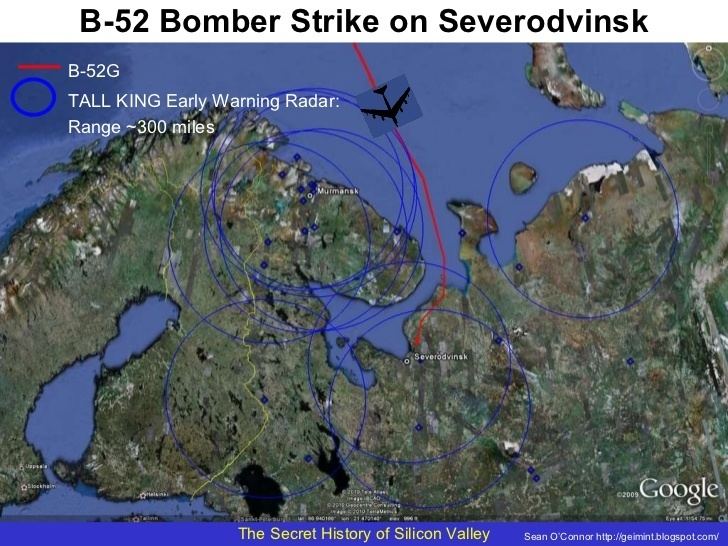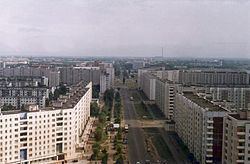Founded 1936 | Population 192,353 (2010) Mayor Mikhail Gmyrin | |
 | ||
Map of Severodvinsk
Severodvinsk (Russian: Северодвинск; [sʲɪvʲɪrɐdˈvʲinsk]) is a city in the north of Arkhangelsk Oblast, Russia, located in the delta of the Northern Dvina River, 35 kilometers (22 mi) west of Arkhangelsk, the administrative center of the oblast. As of the 2010 Census, the population was 192,353. Due to the presence of important military shipyards (specialised in submarines since the Soviet period), Severodvinsk is an access restricted town for foreign citizens. A special pass is required.
Contents
- Map of Severodvinsk
- 15 06 2010 k329 severodvinsk
- Russian nuclear submarine pskov city severodvinsk may 2016
- Pre 20th century
- Modern city
- Administrative and municipal status
- Demographics
- Industry
- Large and military factories
- Transportation
- Sport
- Education
- Higher education institutions
- Monuments
- Cultural heritage
- City in culture
- Notable people
- Twin towns and sister cities
- References

15 06 2010 k329 severodvinsk
Russian nuclear submarine pskov city severodvinsk may 2016
Pre-20th century
Vikings explored the territories around the North Dvina River - part of Bjarmaland - at the start of the first millennium. British and Norman ships came to these places for mining, fur and fishing before the 13th century, but later the climate became colder and access to the northern seas became closed.
The historical records first mention the settlement on the site of modern Severodvinsk in 1419, when the Swedes sailed into the bay and burnt down the Nikolo-Korelsky Monastery that stood by the shore during the Swedish–Novgorodian Wars. Tradition states that Saint Euphemius, an Orthodox missionary in Karelia, founded this monastery. The abbey stood in ruins until 1471, when two sons of Marfa Boretskaya died in a vicious storm; their bodies were recovered on the beach near the monastery twelve days later. At the urging of Boretskaya, the monastery was restored and her sons were buried there.
On August 24, 1553, a ship of Richard Chancellor reached the salt-mining settlement of Nyonoksa, which is still famous for its traditional wooden architecture. The British sailors visited the Nikolo-Korelsky Monastery, where they were surprised to find a community of "sailors in soutanes (cassocks)" and a pier large enough to accommodate several ships. The main church of this extraordinary establishment was dedicated to Saint Nicholas, the holy patron of sailors; hence, the whole White Sea became known in 16th-century English maps as "St. Nicholas Bay". In late 1613, during the Time of Troubles in Russia, Polish-Lithuanian vagabonds, the Lisowczycy, captured and looted Severodvinsk with the monastery.
The Nikolo-Korelsky Monastery flourished after the establishment of the Muscovy Company, as the bulk of their trade passed through the local harbor. In August 1618 the harbour was visited by John Tradescant the elder, who conducted a survey of an island situated opposite the monastery. This island became known to the British as "Rose Island", because it was there that Tradescant found an exceedingly rare plant which he named "Rosa moscovita" and brought back to London.
The surviving buildings of the monastery were constructed at the close of the Muscovite period. The five-domed cathedral of St. Nicholas was built between 1670 and 1674, preceded by the Assumption church (1664–1667), to which it is joined by a gallery. Several decades later, the walls and towers were built of timber; the Soviets transported the best-preserved of these towers to Kolomenskoye, Moscow, where it still remains.
Modern city
Severodvinsk is the second-largest city in Arkhangelsk Oblast. Its main industry remains defense-related — the construction and repair of submarines at the huge Northern Machine-building Enterprise SEVMASH (Северное Машиностроительное Предприятие-СЕВМАШ). The Soviet Union's first nuclear submarine Leninsky Komsomol was built here in 1957. At the beginning of the 1980s the world's largest submarine, a Typhoon class, was also built here, later recorded in the Guinness Book of World Records.
The modern city of Severodvinsk developed in the Soviet period. As it began to be built it was called Sudostroy (Судострой - "Boat-build"). It received town status in 1938 and until 1957 was named Molotovsk (Молотовск), after Vyacheslav Molotov. On September 12, 1957 it was renamed Severodvinsk (meaning "Northern Dvina town").
During World War II a significant portion of the materials delivered by the Arctic Convoys to Murmansk and Arkhangelsk for the Soviet Union were unloaded in Severodvinsk. For example, the Empire Elgar, a British heavy lift ship that arrived in Arkhangelsk with convoy PQ16 and subsequently spent eight weeks unloading ships from the ill-fated convoy PQ17.
A Russian naval-base supports the sea trials of nuclear submarines from the major submarine construction- (64.5817 N, 39.8307 E) and repair-facilities located in the area. In Soviet times the 17th-century buildings of the Nikolo-Korelsky monastery, located on the territory of the shipyard, were adapted and used for shipbuilding purposes. In recent years the monastery buildings, specifically the main church, have been restored and re-consecrated. Church-goers attending services have to be shipyard workers or able to obtain a pass to enter the church portion of the shipyard.
Severodvinsk is an access-restricted town for foreign citizens. A special pass is required.
Administrative and municipal status
Within the framework of administrative divisions, it is, together with eleven rural localities, incorporated as the city of oblast significance of Severodvinsk—an administrative unit with the status equal to that of the districts. As a municipal division, the city of oblast significance of Severodvinsk is incorporated as Severodvinsk Urban Okrug.
Demographics
Population: 192,353 (2010 Census); 201,551 (2002 Census); 248,670 (1989 Census).
From 1950 until 1990, high-tech industries generated demand for a considerable quantity of suitably qualified experts and workers which prompted growth in population. Since 1992, the population has declined due to economic crises and unemployment that has provoked significant migration from the city.
Industry
The main role of the city has been, and remains, the production and repair of submarines and military ships. During the Cold War, the city prospered, but with the decline and break-up of the Soviet Union and the end of the Cold War the city has declined. The city's large military enterprises have survived the economic crises of the 1990s and have adjusted to new economic conditions. Severodvinsk now has the largest shipbuilding yard in Russia for large ships (tankers, cargo ships).
Large and military factories
Transportation
Severodvinsk is the terminal station of a railway line which splits of at Isakogorka station from the line connecting Moscow and Arkhangelsk.
The Kudemskaya narrow-gauge railway in 2010 has appeared in Forbes ranking, of 10 most beautiful railway routes of the world.
Sport
It has a youth bandy team called Sevmash.
Education
In the city there are thirty-two schools, a school for handicapped children, school for orphans, legal school.
School #17 grows regular winners of Russian Olympiads in Physics, many of whom upon completion enter Physics departments of best Universities of the country. Gymnasium #14 is the best Foreign Language school in the city.
Higher education institutions
The city hosts branches of the following institutions:
Monuments
There are approximately twenty monuments and memorial complexes in the city, including:
Cultural heritage
Fifteen objects in Severodvinsk are protected as cultural heritage monuments In particular, the Nyonokotsky Pogost in the village of Nyonoksa is protected as an architecture monument on the federal level. This is one of the few surviving triple wooden church ensembles, consisting of two churches (a bigger, not heated, church used in the summer, a smaller, heated church used in the winter) and a bell-tower. Nyonoksa was also notable for salt production.
In addition, the wooden St. Nicholas Church, currently located on Yagry Island in the northern part of Severodvinsk, was relocated there in 1990s and was the first religious building open in the city. The church was built in the end of 19th century in the village of Solza about 20 kilometers (12 mi) from Severodvinsk.
City in culture
Notable people
Twin towns and sister cities
Severodvinsk is twinned with:
